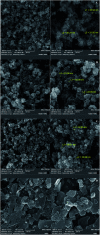Fe3O4@SiO2 nanoparticle supported ionic liquid for green synthesis of antibacterially active 1-carbamoyl-1-phenylureas in water
- PMID: 35542743
- PMCID: PMC9083804
- DOI: 10.1039/c8ra04368j
Fe3O4@SiO2 nanoparticle supported ionic liquid for green synthesis of antibacterially active 1-carbamoyl-1-phenylureas in water
Abstract
In the present work, we have designed a novel, heterogeneous and recyclable magnetic Brønsted acidic ionic liquid based on 5-phenyl-1H-tetrazole. The {Fe3O4@SiO2@(CH2)35-phenyl-1H-tetrazole-SO3H/Cl} ([FSTet-SO3H]Cl) was prepared via the immobilization of 5-phenyl-1H-tetrazole-bonded sulfonic acid onto the surface of silica-coated magnetic nanoparticles using 3-chloropropyltriethoxysilane as a linker. The catalyst was characterized by XRD, TEM, FESEM, EDS, TG-DTA, and FT-IR. The ability and high activity of this catalyst were demonstrated in the synthesis of 1-carbamoyl-1-phenylureas with good to excellent yields via a new, simple and one-pot procedure in aqueous media under reflux conditions. This procedure has advantages such as high yields, short reaction times, a simple methodology and work-up process, green reaction conditions, high stability, catalytic activity, and easy preparation, separation and reusability of the catalyst. The synthesis of these compounds was confirmed by FT-IR, 1H NMR, 13C NMR and CHN. In addition, we investigated the biological properties of the 1-carbamoyl-1-phenylureas as newly synthesized compounds. The described catalyst could be easily separated from the reaction mixture by additional magnetic force and reused several times without a remarkable loss of its catalytic activity and any considerable changes in the product yield and the reaction time.
This journal is © The Royal Society of Chemistry.
Conflict of interest statement
There are no conflicts to declare.
Figures




















Similar articles
-
Magnetite Nanoparticles-Supported APTES as a Powerful and Recoverable Nanocatalyst for the Preparation of 2-Amino-5,10-dihydro- 5,10-dioxo-4H-benzo[g]chromenes and Tetrahydrobenzo[g]quinoline-5,10- diones.Comb Chem High Throughput Screen. 2017;20(1):64-76. doi: 10.2174/1386207319666161223121612. Comb Chem High Throughput Screen. 2017. PMID: 28017132
-
Fe3O4@SiO2@KIT-6 as an Efficient and Reusable Catalyst for the Synthesis of Novel Derivatives of 3,3'-((Aryl-1-phenyl-1H-pyrazol-4- yl)methylene)bis (1H-indole).Comb Chem High Throughput Screen. 2017;20(6):533-538. doi: 10.2174/1386207320666170425123248. Comb Chem High Throughput Screen. 2017. PMID: 28443502
-
Isoniazid-functionalized Fe3O4 Magnetic Nanoparticles as a Green and Efficient Catalyst for the Synthesis of 3, 4-dihydropyrimidin-2(1H)-ones and their Sulfur Derivatives.Curr Org Synth. 2020;17(1):46-54. doi: 10.2174/1570179416666191118110316. Curr Org Synth. 2020. PMID: 32103717
-
Sulfonic Acid-Functionalized Magnetic Nanoparticles as an Efficient Catalyst for the Synthesis of Benzo[4, 5]imidazo[1, 2-a]pyrimidine Derivatives, 2-Aminobenzothia Zolomethylnaphthols and 1-Amidoalkyl-2-naphthols.Curr Org Synth. 2019;16(7):1040-1054. doi: 10.2174/1570179416666190725101422. Curr Org Synth. 2019. PMID: 31984885
-
A Brønsted acidic ionic liquid anchored to magnetite nanoparticles as a novel recoverable heterogeneous catalyst for the Biginelli reaction.RSC Adv. 2021 Feb 11;11(13):7271-7279. doi: 10.1039/d0ra09929e. eCollection 2021 Feb 10. RSC Adv. 2021. PMID: 35423245 Free PMC article.
Cited by
-
Bio-inspired synthesis of palladium nanoparticles fabricated magnetic Fe3O4 nanocomposite over Fritillaria imperialis flower extract as an efficient recyclable catalyst for the reduction of nitroarenes.Sci Rep. 2021 Feb 25;11(1):4515. doi: 10.1038/s41598-021-83854-1. Sci Rep. 2021. PMID: 33633123 Free PMC article.
-
Silica-Based Supported Ionic Liquid-like Phases as Heterogeneous Catalysts.Molecules. 2022 Sep 11;27(18):5900. doi: 10.3390/molecules27185900. Molecules. 2022. PMID: 36144636 Free PMC article. Review.
-
Magnetic chitosan stabilized Cu(II)-tetrazole complex: an effective nanocatalyst for the synthesis of 3-imino-2-phenylisoindolin-1-one derivatives under ultrasound irradiation.Sci Rep. 2022 Apr 25;12(1):6724. doi: 10.1038/s41598-022-10591-4. Sci Rep. 2022. PMID: 35468913 Free PMC article.
-
Magnetic Lignosulfonate-Supported Pd Complex: Renewable Resource-Derived Catalyst for Aqueous Suzuki-Miyaura Reaction.ACS Omega. 2019 Aug 22;4(10):14234-14241. doi: 10.1021/acsomega.9b01640. eCollection 2019 Sep 3. ACS Omega. 2019. PMID: 31508546 Free PMC article.
-
A green approach for the synthesis of 2-substituted benzoxazoles and benzothiazoles via coupling/cyclization reactions.Heliyon. 2021 Nov 3;7(11):e08309. doi: 10.1016/j.heliyon.2021.e08309. eCollection 2021 Nov. Heliyon. 2021. PMID: 34820534 Free PMC article.
References
-
- Marsh K. N. Boxall J. A. Lichtenthaler R. Fluid Phase Equilib. 2004;219:93. doi: 10.1016/j.fluid.2004.02.003. - DOI
-
- Bentivoglio G. Röder T. Fasching M. Buchberger M. Schottenberger H. Sixta H. Lenzinger Ber. 2006;86:154.
-
- Welton T. Chem. Rev. 1999;99(8):2071. doi: 10.1021/cr980032t. - DOI - PubMed
- Yue C. Fang D. Liu L. Yi T. F. J. Mol. Liq. 2011;163:99. doi: 10.1016/j.molliq.2011.09.001. - DOI
- Greaves T. L. Drummond C. J. Chem. Rev. 2008;108:206. doi: 10.1021/cr068040u. - DOI - PubMed
- Hallett J. P. Welton T. Chem. Rev. 2011;111:3508. doi: 10.1021/cr1003248. - DOI - PubMed
-
- Jonathan G. H. Heather D. W. Richard P. S. Ann E. V. Robin D. R. Chem. Commun. 1998;16:1765.
LinkOut - more resources
Full Text Sources
Other Literature Sources
Miscellaneous

